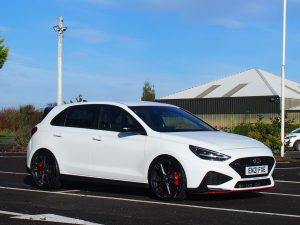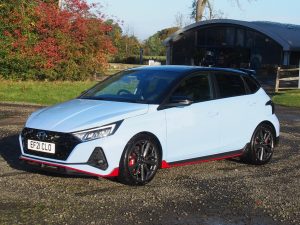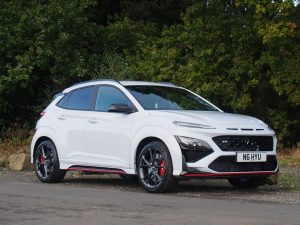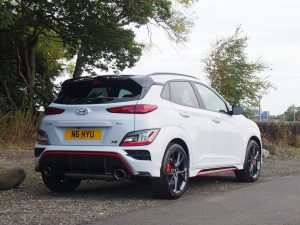… Hyundai, the ‘N’ brand …
 It might be hard to believe but it’s now 4 years since Hyundai introduced its ‘N’ performance brand when it created the i30 N. At the time it seemed an odd choice since the current World Rally Car at that time was based on the i20 model, but there was a reason for that. The i20 was due a refresh so there was no point in bringing out a high performance version as the ‘older’ model was due to be replaced. Hence the i30 N.
It might be hard to believe but it’s now 4 years since Hyundai introduced its ‘N’ performance brand when it created the i30 N. At the time it seemed an odd choice since the current World Rally Car at that time was based on the i20 model, but there was a reason for that. The i20 was due a refresh so there was no point in bringing out a high performance version as the ‘older’ model was due to be replaced. Hence the i30 N.
However, Hyundai pointed out that this would just be the first of a new line and so it has proved with the introduction of the i20 N, Velostar N and more recently the Kona N joining this spirited bunch.
It makes sense, Subaru used rallying to sell its Legacy and Impreza and of course Ford exploited the whole idea with its RS and now ST badges. Renault too has also built up quite an enthusiastic, and well deserved, following for its RS variants as has Audi, and BMW with its ‘M’ cars. VW and Peugeot had their GTi badged cars and although they still have a halo effect on the standard range it doesn’t seem to be anywhere near as strong as the Ford ‘performance identity’ and even Subaru which is no longer involved at WRC level and yet it still has that magnetic attraction to car fans everywhere, no doubt enhanced by the unmistakable beat of a flat four.
But can Hyundai do the same? There’s no reason why not, The company has proved itself on the world rallying scene with two manufacturer titles and if the original roadgoing i30 N is any indication then why not.
I drove one of the original 271 bhp i30 N machines two years ago on a return trip to the Speyside Stages at Elgin from the depths of Lanarkshire. After the rally the trip back home down the deserted roads of the Spey Valley in the gloaming was really quite exhilarating and by the time the A9 was reached it was dark, headlights on and sensible head on. But that drive down the Spey was simply uplifting. It wasn’t the fastest hot hatch around, but it was, and is, one of the best handling and that’s surely what a performance driver wants first before getting more power.
 Similarly, the latest i20 N is a mighty impressive wee motor. The 1.6 litre turbo motor produces a modest but thoroughly responsive and likeable 201 bhp. It also has a mechanical LSD and Launch Control! There are five driving modes from economical and sensible to sports and track modes, but it’s the way the car handles that really impresses. It gets off its mark pretty smartly recording a 0 to 60 time of somewhere between 6 and 7 seconds but the most fun to be had is when the road starts to get curvy and twisty. It’s firm but that’s what you’d expect from a hot supermini.
Similarly, the latest i20 N is a mighty impressive wee motor. The 1.6 litre turbo motor produces a modest but thoroughly responsive and likeable 201 bhp. It also has a mechanical LSD and Launch Control! There are five driving modes from economical and sensible to sports and track modes, but it’s the way the car handles that really impresses. It gets off its mark pretty smartly recording a 0 to 60 time of somewhere between 6 and 7 seconds but the most fun to be had is when the road starts to get curvy and twisty. It’s firm but that’s what you’d expect from a hot supermini.
 The new Kona N is even more impressive. Using the same running gear as the i30 N, this 271 bhp projectile is thoroughly intoxicating. Clothed in a compact SUV style body, it just made me wonder if Hyundai will follow the Ford and Puma route in the WRC by switching from i20 to Kona. After all, SUVs are becoming more popular than saloons.
The new Kona N is even more impressive. Using the same running gear as the i30 N, this 271 bhp projectile is thoroughly intoxicating. Clothed in a compact SUV style body, it just made me wonder if Hyundai will follow the Ford and Puma route in the WRC by switching from i20 to Kona. After all, SUVs are becoming more popular than saloons.
 Anyway, it comes with a variety of driving modes and although it has sports suspension it is adjustable so the driver can select whatever is suitable for his or her mood or depending on whether the grandparents or in-laws are onboard!
Anyway, it comes with a variety of driving modes and although it has sports suspension it is adjustable so the driver can select whatever is suitable for his or her mood or depending on whether the grandparents or in-laws are onboard!
I haven’t driven the Velostar N as yet but given the performance of the other N cars, Hyundai is bound to win new fans amongst driving enthusiasts.
As for the choice of ‘N’ for a performance brand, even Hyundai doesn’t have a definitive answer. Perhaps the fact that the ‘N’ Division is based at the Namyang R&D Centre in Korea might have something to do with it. The car also has an optional ‘Normal’ mode in its performance armoury, but it could also be argued that the N really stands for Nuclear, or Nuts, or maybe even Nakkers – as in, goes like the …
But that is all purely conjecture, although it fits in with Hyundai’s sporting motto “Never just Drive”! Whether it is powered by electricity or hydrogen, Hyundai says ‘N’ will always be about the drive and fun. Every high-performance N model is designed by their passionate experts and engineered at Hyundai Motor’s Namyang R&D Centre. The vehicles are then sent to the Nürburgring in Germany to undergo rigorous testing and validation, so it could be regarded that the brand takes its name from Namyang and Nürburgring.
The aim is to ensure that the N brand excels at delivering driving enthusiasm by providing race track capabilities and, to use their own words, “corner rascal” ride and handling in everyday sports cars.
Given what they have produced so far, the other manufacturers with ‘sporting performance’ brands will have to keep an eye on their own rear vision mirrors – if the cars are not already alongside.
